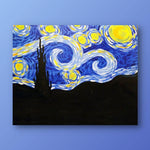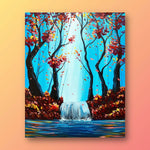9 Tips for How To Use Acrylic Paint Effectively
Are you looking for a fun, new hobby or artistic activity to try? Acrylic paint is a medium that professionals use, but it’s also easy to work with and affordable — perfect for beginners! Keep reading this blog post to learn the benefits of acrylic paints and tips on how to use acrylic paint effectively.

What Are Acrylic Paints?
The three most common types of paint you’ll see in the store include acrylics, watercolors, and oils. Here’s an overview of acrylic paints are and what makes them a great starting point for new and intermediate painters.
Water-Based
There are two basic kinds of paint: water-based and oil-based. Acrylics and watercolors are water-based paints so they’re water-soluble, which means they can be thinned or cleaned up with water. By contrast, traditional oil-based paints are water-resistant and need to be thinned or cleaned off with a paint thinner or mineral spirits.
You also don’t need as many special materials to thin the paint and try out beginner acrylic painting techniques, just water. That said, you can still add paint medium to acrylics for techniques like acrylic pouring or glazing.
Fast-Drying
Acrylic paints and watercolors dry much more quickly than oil paints thanks to their water content. That means you can add new layers or make changes without waiting around for hours or days. Plus, faster drying gives instant gratification to artists who want to display their work right away (like at the end of your painting party).
With most acrylic paints, thin layers can take less than an hour to dry, and thicker acrylic layers may dry before the day's end depending on the size of your painting. By comparison, one layer of an oil painting can take at least a day to completely dry (estimates range from eight hours to 24 hours).
Simple Layering
Watercolors can be very unforgiving when you’re creating layers. A mistake is difficult to cover or fix on highly absorbent watercolor paper. The thin layers of paint don't fully cover previous layers (or errors). And because oil paints take a long time to dry, it may take you several days to complete a multi-layer painting.
With acrylics, it's fairly easy to cover over mistakes with another layer of paint. The ability to layer and experiment is a big benefit for beginners, but even professional artists like the flexibility of acrylics.
Materials You'll Need and the Best Acrylic Paint Brands
If you’re ready to explore acrylic painting, you’ll need a few things to get started. These essential acrylic art supplies won’t be hard to find:
Acrylic Paints
Start with good-quality paint. Choosing an economy paint or children's paint can result in thin, weak colors and cheap-looking finishes that might not last for years to come. Student-grade paint designed for college-level artists can be a great starting point, or you can opt for higher quality artist-grade paint.
Some popular brands of acrylic paint include:
- Winsor & Newton
- Liquitex
- M. Graham
- Blick Studio
- Arteza
- Artist's Loft
Also, each Painting to Gogh kit includes our brand of beginner acrylic paints, which are non-toxic and designed for all ages, along with the other art supplies you’ll need for your project.
A good paint will have solid and smooth coverage with a quick drying time. The final finish for some paint brands is more glossy, while others are more matte. So, be careful when mixing brands or some parts of your painting will have a different look than others.
Paint Brushes
There are eight main types of brushes to use with acrylics, but you can accomplish a lot with less. We recommend picking up these five synthetic brushes: a Round 1, Round 6, Bright 6, Filbert 8, and Flat 12. (All of these brushes are included in our Studio and Essentials painting kits, along with acrylic paints, canvas, an apron, and more.)

Synthetic brushes with smooth bristles give your painting even coverage. Check reviews and avoid brushes that lose shape quickly or have long, splayed bristles that will be hard to control. Your brushes also shouldn't shed as you paint.
Canvas and Easel
Stretched canvas is easy to work with, inexpensive, and long-lasting. Canvas board is easy to store and works well for beginners. Whichever paint surface you prefer, make sure you have a sturdy easel. An easel angles your painting, whether you’re sitting or standing, giving you a straight-on view so you can paint comfortably.
Recommended Reading: Beginner’s Guide to Painting on Canvas
Palette
Paper palettes are perfect for mixing colors and simple cleanup. A reusable palette requires washing each time, which means you may end up with a lot of acrylic paint in your pipes! We find paper palettes are convenient and easy to toss after you finish. A paper plate works great too.
Palette Knife
A palette knife is a flexible blade specially made for painting. Painters use it to blend and mix paint, scrape off any extra, and achieve different techniques like straight lines, fan shapes, and thick textures, so it’s a handy tool.
Water
Since acrylics are water-based, it’s a good idea to have a cup of water to thin your paint or use when you’re ready to wash your brushes.
Scrap Paper
Keep a piece of extra paper off to the side where you can practice strokes or check colors after mixing them.
Paper Towels
Use paper towels to dry your brush and remove excess paint after rinsing it out. Keep paper towels nearby to wipe any paint off your fingers or hand to avoid getting it on any other surfaces. Another tip? Try applying paint with a paper towel to get interesting textures and unique patterns.
9 Handy Tips for Using Acrylic Paint
Once you have your supplies, it's time to get started! Use these quick acrylic painting tips to create a fantastic painting for your home or office. (If you need some inspiration, check out 27 acrylic painting ideas for beginners.)
1. Don't Let Your Palette Dry
Acrylic paints dry quickly, so don't create your palette until you’re ready to paint. If you have to take a break, cover the palette in plastic wrap to keep it wet for a few extra hours. Never leave the caps off your acrylic paints or leave your brushes loaded with paint.
2. Experiment With Blending Colors
Don't just use paint colors straight out of the bottles or tubes — try mixing them up. Use primary colors (red, blue, and yellow) to make your own unique versions of secondary colors (purple, orange, and green).
Adding white will make colors lighter and fainter, creating pastels. Adding black to colors will make them darker and duller (like burgundy or navy). You can also add a brown, more earthy tone to your secondary colors by adding a primary color. For example, adding a little bit of blue to red and yellow will create a burnt orange.
Recommended Reading: How to Blend Acrylic Paint [+ 5 Blending Techniques to Use]
3. Don't Overload Your Brush
Too much paint on your bristles will make it challenging to control the details in your painting and extend the time it takes for your painting to dry. It can also make your brushes tougher to clean all the way.
You can always grab more paint and add more layers to get just the right look. So, only load your brush with as much paint as you need (unless you’re going for a very thick, textured painting).
4. Use a Range of Brushes
Mix up flat brushes, round brushes, and brights for different shapes, brush strokes, and textures. You can also use similar brushes but in different sizes to add variety and small details that make your artwork pop.
5. Try Different Painting Methods
Different tools, acrylic mediums, and techniques can help you get the final result you want. Glazing, for example, adds depth to your colors. We’ve compiled 14 acrylic painting techniques you can test out and make your own.
6. Use a Reference
We recommend creating or printing off a reference image before you get started. Painting from memory can be a challenge — even professional painters create a quick sketch of their idea first, whether with pencil, charcoal, or paint.
Another great way to practice is to follow a tutorial so you can see what you’re aiming to create and get expert tips as you go. Our painting tutorial videos let painters of all ages follow along with an artist, build up their skills, and have fun.
7. Don’t Worry About Mistakes
If you make a mistake, all is not lost. The best way to fix a mistake with acrylic paint is to simply let it dry and paint over it. With that, you’re ready to keep going.
8. Speed Up Drying Time
If you need your layers to dry a little faster, break out a hair dryer. Set it to its coolest, lowest setting to avoid making the paint bubble or crack. Hold the blow dryer at least 6 inches away from the canvas and keep it moving to avoid sitting in one spot too long.
9. Get all the Paint Out of Your Brushes
One of our biggest tips is to clean your brushes thoroughly — try not to let any acrylic paint dry in the bristles. Acrylics dry to a plasticky finish that’s tough to remove after they’ve set. While you’re painting, keep the brushes you’re using in a cup of water to make clean-up much easier. Just don’t let them sit for hours and hours.
When you’re done painting, always rinse your brushes in the water by gently dabbing them on the bottom of the cup. Then, use a paper towel to dry the brush, reshaping the bristles into their original form and setting them aside to fully dry. Paint brushes can last a long time when they’re cared for properly.
Painting to Gogh Is the Perfect Way to Learn How To Use Acrylic Paint
Our step-by-step painting tutorials take away the guesswork as you’re learning to work with acrylics.
Simply choose the type of painting that looks fun and interesting to you (or your family and friends) and focus on practicing your painting technique. Learn how to blend colors, use brushes, and create textures that result in beautiful paintings you’ll enjoy for years to come.
Ready to become an acrylic painting master? Choose your painting and kit now.














